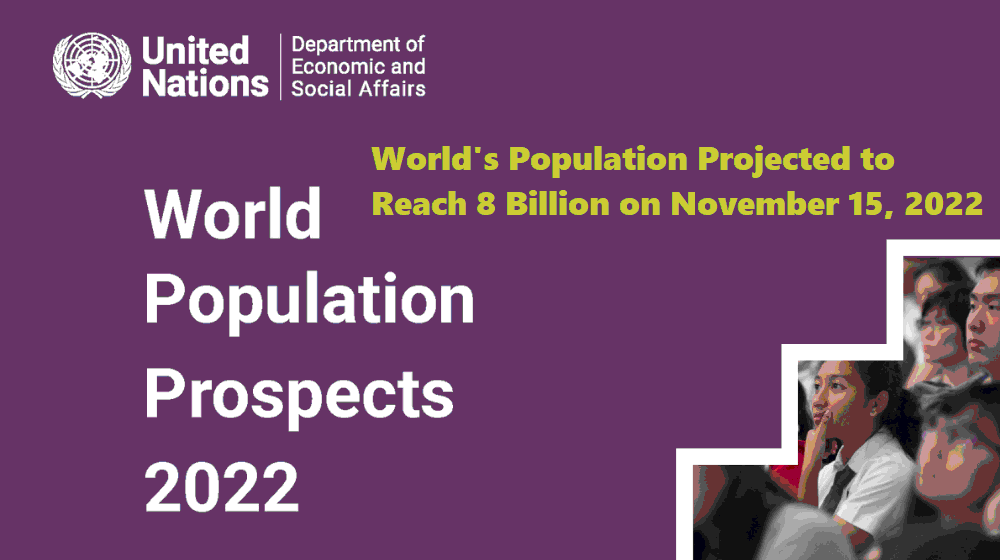
According to United Nations projections, the world's population has reached eight billion since Tuesday. On July 11, the United Nations Population Fund (UNFPA) announced the fact that the world's population will reach eight billion on November 15. On July 11, 1987, the world's population was about five billion. The World Population Prospects 2022 released four months ago by the World Population Fund predicts that the world's population will reach a peak of 10.4 billion in the 2080s and remain at the same level until the year 2100.
The Global Population Prospects report released on 15 November 2022 states that the global population is now growing at its slowest rate since 1950, reducing to 1% in 2020. It has taken 12 years to increase the global population from 7 to 8 billion, it may take about 15 years to reach 9 million. By the year 2037, it is believed that the overall growth rate of the global population may slow down even more.
It has been analyzed that the population has become larger than before due to the increase in average life expectancy and decreasing infant and maternal mortality rates. According to the fund, it took 12 years for the world's population to reach seven to eight billion. It took the same time to reach six to seven billion. Looking at the current growth rate, it is estimated that it will take about 14 and a half years to add another billion.
Of the eight billion added to the world population, half is the result of demographic expansion in Asia. Africa is the second largest contributor to this. The continent has a population of 400 million. Looking at the world population statistics, 10 countries have contributed more than half of the population growth of seven to eight billion. India has been the largest contributor to this growth. According to the fund, the growth rates of China and Nigeria are in second and third place respectively.
East and Southeast Asia with 2.3 billion people, Central and South Asia with 2.1 billion people, and China and India with over 1.4 billion each account for the majority of the population.
Based on the projected increase in global population by 2050, it will be concentrated in only 8 countries, namely, Congo, Egypt, Ethiopia, Pakistan, India, Philippines, and Tanzania, the world's largest country by the growth rate, re-ranking them by size. Will be arranged. According to the estimates of the United Nations, during the year 2023, India can emerge as the most populous country in the world. In which it can even beat China.
China has the largest population in the world at 1.45 billion and India is the second with a population of 1.4 billion. Third America has a population of 330 million.
By 2023, India is projected to surpass China in terms of population. Africa and Asia will lead population growth until reaching nine billion, which will be achieved by 2037. About two-thirds of the world's population are women of childbearing potential. The birth rate of women living in such a country or region is less than 2.1 per woman.
As the population grows, both challenges and opportunities increase, according to the United Nations. According to the preliminary results of the National Census, 2078, Nepal now has a population of 291 lakhs 92 thousand 480 people.
Population Growth and Death Rate:
Population growth is partly due to a decline in the death rate, a reflex of increased levels of life expectancy at birth. Globally, life expectancy reached 72.8 years in 2019, a further increase of almost 9 years since 1990. A further reduction in mortality is also projected to result in global average longevity of about 77.2 years in 2050.
Countries with the highest fertility levels tend to have the lowest per capita income, so global population growth has over time been concentrated in the world's poorest countries, most of which are in sub-Saharan Africa. Rapid population growth in all these countries can thwart the achievement of the Sustainable Development Goals, the world's best path toward a happy and healthy future.
Why is the environmental balance deteriorating due to population growth?
Population growth increases the environmental impact of economic development. Growth in per capita income is the main driver of a stable pattern of production and consumption. The countries with the highest per capita consumption of material resources and greenhouse gas emissions are those with high per capita income, not those with the fastest growing populations.
According to the United Nations, meeting the goals of the First Agreement to limit global warming, while achieving the Sustainable Development Goals, depends critically on preventing unsustainable patterns of production and consumption. Slow population growth in many countries for many years could help reduce the further accumulation of environmental damage in the second half of the current century.





